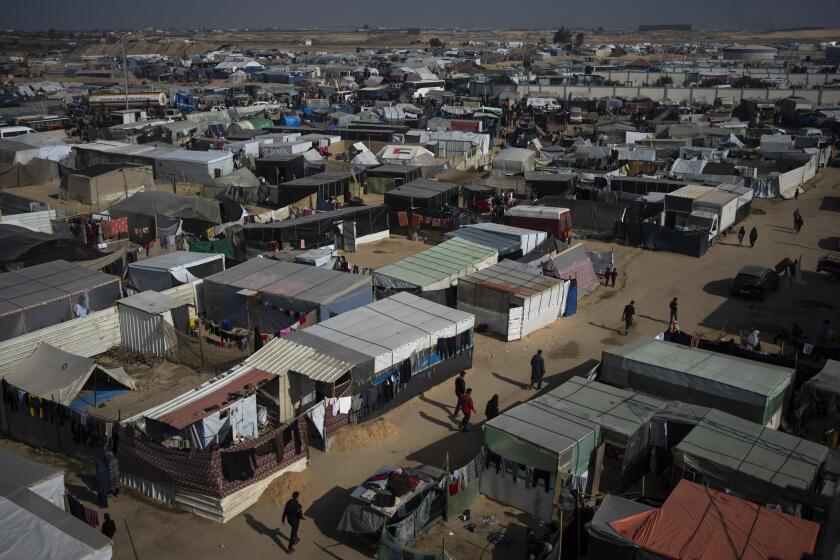A Spiritual Icon Returns to Russia
A radiant image of the mother of God and her somber-faced child, so enchanting that it inspired Ivan the Terrible to build a monastery, has returned to its home in Russia, luring tens of thousands of people to stand in line for hours to see it.
All day Friday, a chain of people stretched for up to a mile around the Church of the Savior in central Moscow, where the Virgin of Tikhvin icon -- considered a protector of the nation since the 14th century -- returned this week after a 60-year hiatus in the United States.
By midday, visitors were facing waits as long as three hours to enter the church and approach the large, silver-framed icon that was hidden after the 1917 Bolshevik Revolution, smuggled out of the Soviet Union after World War II and reposited in the home and church of a Russian Orthodox archbishop in Chicago.
“The return of the icon of Our Lady of Tikhvin is a convincing indication that the macabre period in Russia’s history is finally coming to an end. After more than seven decades, both the people and the country’s leadership are ceasing to be spiritually blind,” said Father Vsevolod Chaplin, a spokesman for the Russian Orthodox Church’s Moscow patriarchy.
The size of the crowds -- at least 8,000 by official count Thursday and probably an equal number Friday -- is testimony to the growing power of the Orthodox Church in a country in which believers were persecuted for more than 70 years during the Soviet era.
The white towers and gleaming gold onion domes of the Church of the Savior were rebuilt during the post-Communist presidency of Boris N. Yeltsin, decades after Josef Stalin ordered the church demolished and, eventually, replaced with a public swimming pool.
Vendors hawked piroshki, sodas and prayer books to those standing patiently in the chilly summer breeze. Young mothers pushed strollers, and an engineer who had taken the day off work stood with his mother clutching his arm. The old woman, with a mouthful of gold teeth and a leopard-print scarf, squinted and thought about the words of the song she would sing once she approached the icon.
“Really, Russian people simply can’t ignore something like this. Our soul is burning. It requires that we come,” said Valentina Panchenko, a dental clinic receptionist. “An icon is a primary thing of worship for believers, especially if it’s an icon of the Holy Virgin. Icons like this have the ability to make miracles, like healing people. I’ve seen it happen.”
The legend of the icon’s debut in Russia is part of its mystery. Widely believed to have been painted by St. Luke the Evangelist when Mary was still alive, the icon subsequently moved from Jerusalem to Constantinople, now Istanbul, Turkey.
Eventually it arrived in Russia. On July 9, 1383, fishermen in the town of Tikhvin, about 125 miles from St. Petersburg, saw an unusual light in the sky and traced it to the icon, the location of which marked the building spot for a cathedral.
Ivan, the future czar, arrived in Tikhvin to pay homage to the icon in 1547 and called for the construction of a monastery there. Over the ensuing years, the icon in its jeweled case became known as a protector of Russia, credited with shoring up resistance to invading Swedes and Poles, among others.
It was hidden from the Communists after 1917. In the closing days of World War II, it was in Latvia.
When the Soviets annexed Latvia after the war, Bishop John Garklavs fled and carried the icon with him to the United States, keeping it in Chicago after he became archbishop there. His adopted son, Sergei Garklavs, helped fulfill the archbishop’s wish that the icon return to the Tikhvin monastery if it reopened.
Under an agreement between the U.S. and Russian Orthodox churches this year, the Russians are restoring the monastery in exchange for the icon’s return.
On Sunday, Russian Patriarch Alexei II will lead a procession with the 34-by-43-inch icon through Red Square and the churches of the Kremlin. The next day, it will move to St. Petersburg and on July 8, to Tikhvin. Authorities there have set up campgrounds and food stations for 3,000 visitors.
In the meantime, the icon stands ready for visitors 24 hours a day in the big church on the banks of the Moscow River.
“We lined up for three hours to see it, and it was absolutely worth it,” said Igor Sorokin, a 21-year-old cellphone technician, who said he kissed the icon. Some people, he observed, merely brushed it with their palms. Some sang hymns at its side or laid flowers. Some just stood in awe of its austere beauty.
Sorokin was absolutely sure that the icon could work wonders. “There’s no doubt about it at all,” he said.
But what miracles should it conjure?
“Maybe, finally, Russia and its people will be able to go back to the good life. The way it was before 1917,” Sorokin said. “Back to Russia the way it was.”
Times staff writer Alexei V. Kuznetsov contributed to this report.
More to Read
Sign up for Essential California
The most important California stories and recommendations in your inbox every morning.
You may occasionally receive promotional content from the Los Angeles Times.






